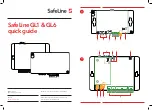
Gx Interface Support
▀ Assume Positive for Gx
▄ Cisco ASR 5x00 Packet Data Network Gateway Administration Guide
330
QVI
Gx Back off Functionality
This scenario is applicable when Primary PCRF cluster is unavailable but the secondary PCRF is available to handle
new CCR-I messages.
When the chassis receives 3004 result-code then back-off timer will be started for the peer and when the timer is
running no messages will be sent to that peer.
The timer will be started only when the value is being configured under endpoint configuration.
Releases prior to 15.0, when the IP CAN session falls back to local policy it remained with local policy until the
termination timer expires or the subscriber disconnects. Also, the RAR message received when the local-policy timer
was running got rejected with the cause "Unknown Session ID".
In 15.0 and later releases, P-GW/GGSN provides a fair chance for the subscriber to reconnect with PCRF in the event of
CCR failure. To support this feature, configurable validity and peer backoff timers are introduced in the Local Policy
Service and Diameter endpoint configuration commands. Also, the RAR received when the local-policy timer is running
will be rejected with the cause "DIAMETER_UNABLE_TO_DELIVER".
Configuring Gx Assume Positive Feature
To configure Gx Assume Positive functionality:
Step 1
At the global configuration level, configure Local Policy service for subscribers as described in the
Configuring Local
Policy Service at Global Configuration Level
section.
Step 2
At the global configuration level, configure the failure handling template to use the Local Policy service as described in
the
Configuring Failure Handling Template at Global Configuration Level
section.
Step 3
Within the IMS Authorization service, associate local policy service and failure handling template as described in the
Associating Local Policy Service and Failure Handling Template
section.
Step 4
Verify your configuration as described in the
Verifying Local Policy Service Configuration
section.
Step 5
Save your configuration to flash memory, an external memory device, and/or a network location using the Exec mode
command
save configuration
. For additional information on how to verify and save configuration files, refer to the
System Administration Guide
and the
Command Line Interface Reference
.
Important:
Commands used in the configuration examples in this section provide base functionality to
the extent that the most common or likely commands and/or keyword options are presented. In many cases,
other optional commands and/or keyword options are available. Refer to the
Command Line Interface
Reference
for complete information regarding all commands.
Configuring Local Policy Service at Global Configuration Level
Use the following example to configure Local Policy Service at global configuration level for subscribers:
configure
local-policy-service
LOCAL_PCC
















































